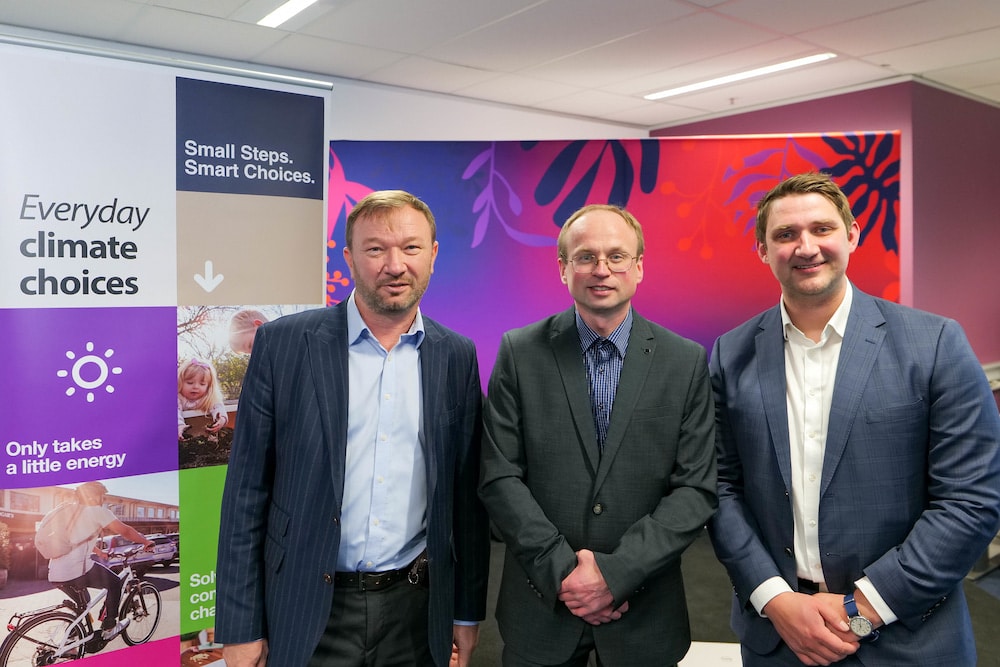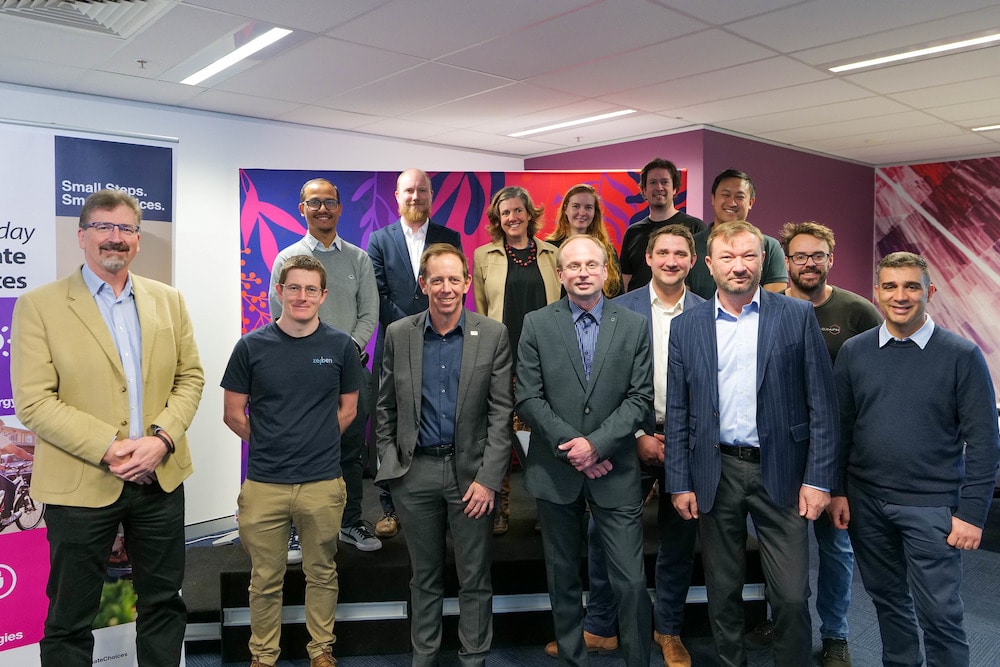A Canberra company is about to design a boat that produces hydrogen on board – one of the first times this has been tried anywhere in the world. That could lead to the decarbonisation of major industries, and eventually to entire cities powered by clean hydrogen.
Other local companies are reducing waste from solar panels, and making more efficient panels that last longer, or improving community batteries.
These are among the six projects funded in the third round of the ACT Government’s Renewable Energy Innovation Fund (REIF), totalling more than $1.2 million.
Canberra is a centre of renewable energy industry excellence, Shane Rattenbury, ACT Minister for Water, Energy and Emissions Reduction, argued.
“I am excited about what we can achieve,” Mr Rattenbury said. “Canberra sits as a frontrunner in addressing issues of climate change, electrification, and the transition to a clean energy future. These projects will continue to position us in this way, but also tackle the big picture reason, which is to respond to climate change, to cut our emissions as quickly as possible, and to make sure we hand a good planet to future generations.”
A hydrogen-powered future, created in Canberra
Hydrogen Renewable Energy Australia (HyREA), a Canberra-based green energy startup, received more than $254,000 to research producing green hydrogen quickly and conveniently on site.

“Hydrogen is a green energy alternative,” Andrey Turenko, one of the directors, said. “If it’s created in a sustainable and green way using renewable energy, there are no carbon emissions that lead to global warming and other poor climate outcomes.”
But hydrogen is difficult to store and transport, preventing its widespread adoption, Mr Turenko explained. However, the company is developing technology to produce hydrogen on-site and on-demand from any kind of water.
The process – developed at the ANU School of Physics, where his co-directors, both academics, work – sucks oxygen out of water, and releases pure hydrogen as the by-product. The pure hydrogen can then be captured in a solid hydrogen cell, and used as fuel.
“By making hydrogen easy to store and transport, we open up a whole array of opportunities,” Mr Turenko said. “We believe that we can decarbonise the maritime industry as a start. That accounts for two to three per cent of global emissions right now.”
To demonstrate their process, they will create a prototype boat that is both powered by a hydrogen fuel cell, and that can produce hydrogen onboard.
It is, Mr Turenko said, a practical and workable solution to refuelling boats and vessels easily, conveniently, and affordably.
“As far as we know, that capacity or capability to produce hydrogen on board the vessel is one of the first times this has been tried anywhere in the world, so we’re very excited about it,” Mr Turenko said.
“Typically, you will either compress or liquefy hydrogen, and bring it on board, but that limits how much you can actually store, and limits the range of the boat distance.
“Our boat will produce hydrogen on-site the vessel, meaning we can power the boat for longer.”
Beyond the shipping industry, HyREA looks to decarbonise other industries, such as freight, trucking, and heavy industries, and to export energy overseas.
“Australia’s very lucky, because we have an abundance of renewable resources,” Mr Turenko said. “We have solar in abundance, so we can use that energy to create [the solid hydrogen cell], and then we can export it to where it’s needed.
“We’re starting from shipping, but there’s nothing stopping us from powering entire cities using this method. While this is quite a long-term ambition, theoretically it is something we are very excited about, and something we’d like to work towards.”
HyREA was established two years ago, its vision “to bring this green technology to the masses and demonstrate its usefulness and potential”, Mr Turenko said. The ACT Government grant made a “huge” difference.
“We’ve been lucky that we’ve managed to progress our work in a number of different directions – but obviously, funding is the limiting factor,” Mr Turenko said.
“Receiving this REIF grant funding is going to be an enormous help. It helps support to deliver an actual working prototype, which will then hopefully demonstrate this technology to bigger and wider audiences. Without this grant, I don’t think that would have been possible, or certainly wouldn’t have been possible as quickly.”
Mr Rattenbury believes the project is timely, given the Federal Government invested $2 billion in the recent budget to accelerate large-scale renewable hydrogen projects, and make Australia a world-leading hydrogen producer and exporter.
“The hydrogen possibilities seem endless at the moment,” Mr Rattenbury said.
Less waste from solar panels
Three projects funded in this year’s REIF round aim to increase the efficiency of solar panels.
PV Lab Australia, a Canberra-based test-lab for photovoltaic modules and components, received nearly $214,400 to prevent solar panels from ending up in landfill, by reducing the number of panels that get thrown away and finding ways to reuse them instead.

“At the moment, there’s a bit of a problem with what happens at the end of life for solar panels,” managing partner Michelle McCann said. “Many solar panels are taken off rooves or out of use when they’re still functioning, and some are taken out when they’re not functioning anymore…
“They might throw them out because they’ve had an extension done to their roof, and they don’t fit anymore, or they’re upgrading their system, and so they want a newer better one.
“But what can we do to reduce that mass of stuff going to landfill, or, as is sometimes the case, being dumped offshore as e-waste?”
The government grant will allow them to address that problem, Ms McCann believes.
“We’re a business,” she said. “We test solar panels for a living. We don’t do work that people don’t pay us to do, but having this grant money come in allows us to investigate this area that we know is a problem. We’ve got some ideas and thoughts on how we can address [it], but without having a bit of support to do it, we’ve got no means to go and do it. But we feel like we have a responsibility to do it. So when the grant came out, we almost felt like we had to apply.”
PV Lab’s solution is to ‘reduce’ waste and to ‘reuse’ solar panels. Improving the quality of panels coming in would reduce waste, for instance.
A second-hand market for solar panels would address the ‘reuse’ issue. After all, Ms McCann points out, people sell their old cars when they get a new model; they don’t simply throw them out.
Dr Rabin Basnet, PV Lab’s engineer partner at ANU, will develop tests to see whether panels can be reused, or refurbished. “Can they be fixed and made to work again?” Ms McCann wonders.
The researchers will also test a back sheet paint, developed by Dow Chemical, that might give solar panels a second life.
“We’ll test that out with some Australian panels, putting them out in the sunshine, seeing how they respond,” Ms McCann said.
PV Lab has partnered with the Circular PV Alliance to look at keeping solar panels in the closed loop system (recycling and reusing solar panels to supply the material used to create a new solar panel).
Solar panels have an energetic payback time of 18 months to three years, Ms McCann observed.
“As long as they’ve lasted that long, they’ve generated enough energy to pay back the energy that it took to create them – but it’s still a wasted resource. Obviously, the Earth has finite resources.”
Another company, Syenta (formerly SPARK3D), received more than $254,000 to use 3D printing technology to reduce waste and energy consumption in the production of solar panels, and to develop a method to easily take apart and reuse the electronic components, making the manufacturing process more circular. Scientists, engineers, and innovators in the ACT will be able to use this technology to speed up the development and commercialisation of renewable energy technology.
Aqacia, a machine-learning startup at the ANU School of Physics, received more than $82,300 to use machine learning and image recognition technology to improve the quality control of solar panels. Their prototype accurately assesses and classifies the quality of solar panels. Aqacia says it expects to achieve faster, more cost-effective, and consistent quality assurance – a solution that can be exported around the world.
More viable community batteries
In 2045, the ACT Government intends, the city will be powered by renewable electricity, and community batteries will play a big part. The Big Canberra Battery is promised to provide at least 250 megawatts of power, while the Federal Government will fund three in Casey, Dickson, and Fadden.
Two other projects funded by the REIF will help with that transition.
- ACT Government signs contract for Big Canberra Battery (13 April)
- Labor announces community battery rollout for ACT (20 December 2022)
Software company Zepben received $250,000 to create Community Energy Opportunity Toolkit, a web-based tool that identifies suitable locations for community batteries. The company says this will accelerate the transition to clean and sustainable energy by making community batteries more economically viable.
“In the context of seeking to electrify our whole city, this would be a terrific project,” Mr Rattenbury said.
- ACT reveals pathway to electrification (4 August 2022)
Flexegraph, a spin-out from the ANU, received $180,000 to improve the lifespan of large battery energy storage systems through enhanced thermal management, leading to longer-lasting and more efficient energy storage systems.
“Given the acceleration of battery rollout, [this is] a terrifically valuable project,” Mr Rattenbury said.



